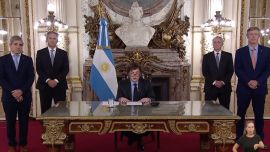Will Miguel Díaz-Canel – the first president after the Castro dynasty – be able to steer the heavy wheel of impoverished Cuba? It seems a difficult task. Change and especially political change has been a managed affair on the island for nearly six decades. Any progress in that matter has been closely constrained and consciously delayed by both the Castro brothers and the “históricos” dinosaurs of the 1959 revolution.
“A major change in the short run is out of the question,” says Rafael Bielsa, foreign minister during the Néstor Kirchner presidency (2003-7). “Cuba has its own inner ecosystem which cannot but continue being ruled by the ‘square under siege’ theory,” he tells the Times, arguing that, as a general rule and because of their historical
political insulation, Cubans are a mistrustful people. “If there is going to be any change, then it will be like [singer] Luis Fonsi’s hit ‘Despacito’: ‘pasito a pasito’ (“step-by-step”),” he adds.
It is not the first time that a “promise of change” has knocked at the Cuban door. In the early 2000s Fidel Castro did name two ‘youngsters,’ Felipe Pérez Roque (secretary of state) and Carlos Lage (vice-president), who were quickly seen as the new generation who would succeed the revolutionary dinosaurs. But in March, 2009, they were thrown from the Communist government helm by Fidel, who in an article published later in Granma, the official gazette, called them “unworthy’’ and said “the honey of power awakened in them ambitions filling the enemies of Cuba with hope.”
Perhaps taking into account that chapter of recent history is why this week the Cuban National Assembly which voted for Diaz-Canel for president asked the cubanos to comment and retweet the hashtag #somoscontinuidad (“we are continuity”). Just in case anyone would dare forget. So if change is to be restrained within the island and the new president will be hemmed in from within by the Communist Party, still headed by Raúl Castro – and the Interior Ministry (intelligence and counterintelligence), run by the the outgoing leader’s son Alejandro – can a shift be pushed from the outside, namely from Washington?
“The US-Cuba relationship is not an international relations policy but a domestic policy,” Eduardo Mestre tells the Times. Mr. Mestre is a Wall Street banker who sits on the board of Cuba Study Group, a think-tank which has been promoting the creation of a private sector in the island.
“Nothing much will change in the US-Cuba relationship,” he argues, pointing out that with the November midterm elections around the corner, Donald Trump will feel compelled to stand by Senator Marco Rubio’s electorate (a Florida Republican, re-elected to the Senate in 2016).
Florida was one of the decisive states in Trump’s presidential race two years ago and Senator Rubio’s anti-Castro narrative helped. No wonder: of the 1.7 million Cubans and Cuban-descendants who live in the US, 1.2 million are concentrated in the Sunshine State.
“Everything in Cuba is opaque”, continues Mestre, “and in that sense no-one knows how Díaz-Canel thinks or if he has the political skill to reunify the exchange rate or regulate the private sector.”
There is not much footage, or even public statements, available of Díaz-Canel. Even Michael Reid at The Economist asks himself if he is a reformer or a reactionary. One Argentine politician closely linked to the PCC (Cuban Communist Party) says that the new president is “100 percent apparatchnik” and that he will play on the safe side regarding politics.
He has already done so regarding the aforementioned Cuba Study Group. In February, 2017, Díaz-Canel publicly accused the think-tank of seeking to foment a “loyal opposition” to the régime via the promotion of the self-employed sector.
“These are people who use a highly structured language and discourse to avoid directly facing up to the Cuban Revolution,” said Díaz-Canel, accusing them of being a “gringo” Trojan horse sneaked onto the island.
Is there any sign of a move from the Trump administration? Will there be a positive shift in Havana-Washington relations? “We’re not sure that that’s going to happen. We would like a freer and more democratic Cuba. We will be watching but aren’t overly optimistic, because this isn’t a democratic process,” said US State Department Spokeswoman Heather Nauert.
Perhaps the move will be in the other direction. Washington pundits seem to think that “influential voices in Congress feel that the Trump administration’s regulatory changes did not go far enough.” So there would be more to come.
For its part, the Cuba Study Group stresses that after the alleged “sonic attacks” suffered by US personnel at the Havana Embassy, 24 people were sent back leaving “our diplomatic presence in Havana depleted.” With now a small almost symbolic staff of just a dozen diplomats left at the Embassy in Havana, “US foreign policy institutions are flying blind,” it says.
However, the new US Secretary of State Mike Pompeo, during his confirmation hearing last week before the Senate Foreign Relations Committee, said he would seek to improve ties with Cuba. Regarding the downsized Embassy in Havana, he committed himself “to build up a team there that will deliver American diplomacy to Cuba in a way that represents the finest of American diplomacy.” Wishful rhetorical thinking, or one small step toward a change on the Cuba issue?
The missing link though, that we’ve not explored, is how the Havana government views the Trump administration. “Over and above the US president’s zigzagging approach to foreign policy, the Cuban helm and intelligence might already have a pretty accurate X-ray of what’s cooking in Washington,” asserts former foreign minister Bielsa.
Recalling an illustrative moment – published here for the first time – Bielsa shares an anecdote about his former counterpart and colleague, then-US secretary of state Colin Powell when flying on Air Force One from Santiago de Chile to Buenos Aires in June, 2003.
Secretary Powell, he says, told him that Fidel Castro had sent him an envelope, containing some pages from the US official’s book Soldier’s Way, which had been translated into Spanish. The pages contained commentaries scribbled in the margins, in Fidel’s own handwriting. Attached to these there was a little note saying: “Estimado General, sepa Ud. que sigo su pensamiento (rough translation: “Esteemed general, know that I am reading your mind.”)"
Some 15 years on, Fidel has died and Raul has, allegedly, passed on the baton. Today, over 80 percent of Cubans have only known a Castro, whether Fidel or Raúl, as president. From that standpoint, this is doubtless a pivotal moment for Cuba, at least symbolically.
The real question is at what speed the future can unfold and that is difficult to gauge. All the more so because while the Castro dynasty and the PCC are apparently imposing on Díaz-Canel a slow-ticking clock to delay change and freeze a revolution already almost 60 years old, across the water the Trump administration has been reversing away at full speed from Barack Obama’s opening and easing of commercial and tourist restrictions to Cuba.
Cuba has witnessed a historic handover. But for the immediate future at least, nothing new is arising from the change that will bridge the 165-kilometre gap between Havana and Key West and help Cuba escape its isolated island state.























Comments